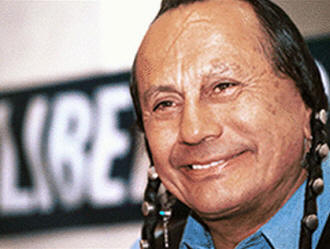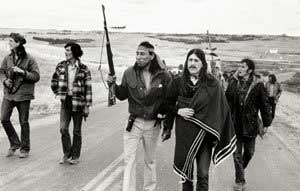Policy and History of the Native Americans
Alexander S. Peak
Also available in: .txt .pdf .mp3.
18 February 2002
Russell Means, a prominent A.I.M. leader, was a contender for the Libertarian Party presidential nomination in 1988. The Libertarian Party platform states, “The rights of American Indians have been usurped over the years. We support the following remedies: (1) individuals should be free to select their own citizenship and tribes should be free to select the level of autonomy the tribe wishes, (2) Indians should have their property rights restored, including rights of easement, access, hunting, and fishing, (3) the Bureau of Indian Affairs should be abolished leaving tribal members to determine their own system of governance, and (4) negotiations should be undertaken to resolve all outstanding differences between the tribes and the government.”
In my opinion, the United States has never treated the Native Americans fairly. For one, the policies that the United States of America created for the Native Americans were primarily used to push them around; and, although it is a cliché to say it, it has stolen their land and driven them to extremes. It has forced them to change who they are, and the only thing that it has given them in return is the vice of alcoholism.
The Native American policy of the United States has been to assimilate the Natives into the established American culture or push them away to open up more land for white Americans. The Native Americans were long viewed as being inferior to the white establishment; thus, the white establishment did not mind screwing-over the Native Americans to achieve its objectives. And, it was the goal of the federal government to gain land and wealth at the expense of these “savages.” At first, only the land on the eastern part of what would become the United States of America was being seized by the European settlers. As time went on, and manifest destiny became a clear (and maybe even reachable) goal, the United States’ government began forcing many Native tribes to sign treaties surrendering portions of their land to the “Americans.” If a tribe failed to comply with the government backed treaty, a war would be sure to take place. With more-modern and -efficient weapons, the “Americans” were nearly always sure to win. Eventually, Native American tribes lost all but a small percent of their land. The lands they did get to keep were called Indian Reserves. In the end, the whites/government took by force the Native Americans’ land, forced them to accept established culture, and actively promoted assimilation as a “positive” way to teach Native Americans to reject their culture and heritage; and the “Americans” gained the benefits: land, wealth, and power.
There were many sub-policies that contributed to the main goal of the United States’ government. Of course, there were the treaties that not only made the Native Americans agree to “keep peace with the settlers and to recognize the jurisdiction of the United States government,” but that also required the Natives to surrender allotments of their land to the white settlers. In exchange, their rights to the “natural resources on the land, as well as the fishing and hunting rights there” were recognized; these being, of course, rights they already had. The natives were also guaranteed a cash payment and protection, but as to whether these promises were well kept, I am not so sure. In 1824, the Bureau of Indian Affairs was established, and in 1830, the Indian Removal Act was passed. This act was used to allow the U.S. president to force Native American tribes in the eastern portion of the United States to move west of the Mississippi River, and within the next ten years, 70,000 Native Americans had been forced to move. But even that wasn’t enough, for eventually the “Americans” wanted the west as well. Railroads, the gold rush, the Civil War, and westward expansion all made the western United States more appealing. In 1871, Congress decided that it would be easier to screw the Native Americans over by making treaties unnecessary, and tribes were placed under the Guardianship Act. The Dawes Act of 1887 was another way for the United States’ government to take away land from the Native Americans and profit by selling the land to whites. Land was now to be owned by individual Native Americans rather than by tribes, which was another way of forcibly conforming their standards and “Americanizing” them. The tide changed course only slightly by 1924, the year the Indian Citizenship Act was passed, giving U.S. born Native Americans U.S. citizenship. Native Americans living on reservations did not have to pay taxes for land, and all Native Americans were granted authority to vote. In 1934, the Wheeler Howard Reorganization Act was passed which stopped “loss of reservation lands by Native Americans” and patronizingly “provided for limited self-government through tribal councils elected by the adults of a tribe.” Not surprisingly, many Natives remained resentful of the federal government for its years of thievery, lies, and disregard for rights.
Native Americans at Wounded Knee in 1973.
An Indian Power movement ultimately began in the late 1960s. In 1972, the American Indian Movement (AIM) and other such activist groups carried out a protest against the Bureau of Indian Affairs by occupying its headquarters in Washington, D.C. To bring attention to the Indian Rights Movement, AIM took over the village of Wounded Knee in South Dakota in 1973 and called for the return of the land that had been promised in treaties. There, two FBI agents and one Native American were killed in a standoff. A huge manhunt ensued, one of the largest to have ever taken place in the United States. A Native American was arrested but was acquitted of the charges; however, the federal government made an illegal deal with Canada and the Native American was sentenced anyway. Hundreds of pages concerning this incident are still classified due to reasons of alleged “National Security.” Thus, as it turns out, the U.S. government is still committing corrupt actions with regards to the Native American peoples.
None of this, of course, has had a very positive effect on Native Americans. The Natives who were assimilated into mainstream culture found themselves questioning exactly where they fit into it. The drinking rate among Native Americans is greater than among any other ethic group in America; the same thing can be said about the rate of drug use, the unemployment rate, and the suicide rate. And one could truly say that the white establishment has left them depressed, oppressed, and with nearly nothing really to do.
[Online Note: I do not actually recall writing this paper. As the date indicates, it must have been written when I was back in high school. While I would probably not write the paper in the same way today, I retain my belief that native Americans’ rights have been systematically infringed upon by the state apparatus.]


